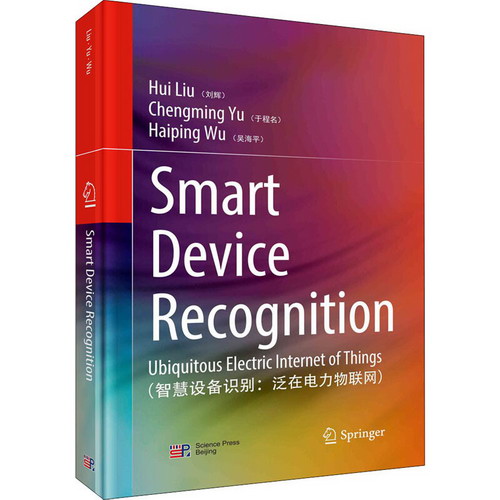| | | | 智能設備識別:泛在電力物聯網 | | 該商品所屬分類:圖書 -> 科技 | | 【市場價】 | 1545-2240元 | | 【優惠價】 | 966-1400元 | | 【出版社】 | 科學出版社 | | 【ISBN】 | 9787030673794 | | 【折扣說明】 | 一次購物滿999元台幣免運費+贈品
一次購物滿2000元台幣95折+免運費+贈品
一次購物滿3000元台幣92折+免運費+贈品
一次購物滿4000元台幣88折+免運費+贈品
| | 【本期贈品】 | ①優質無紡布環保袋,做工棒!②品牌簽字筆 ③品牌手帕紙巾
|
|
| 版本 | 正版全新電子版PDF檔 | | 您已选择: | 正版全新 | 溫馨提示:如果有多種選項,請先選擇再點擊加入購物車。*. 電子圖書價格是0.69折,例如了得網價格是100元,電子書pdf的價格則是69元。
*. 購買電子書不支持貨到付款,購買時選擇atm或者超商、PayPal付款。付款後1-24小時內通過郵件傳輸給您。
*. 如果收到的電子書不滿意,可以聯絡我們退款。謝謝。 | | | |
| | 內容介紹 | |

出版社:科學出版社 ISBN:9787030673794 商品編碼:10026732419287 品牌:文軒 出版時間:2021-03-01 代碼:188
"
作 者:劉輝,於程名,吳海平 編  定 價:188  出 版 社:科學出版社  出版日期:2021年03月01日  裝 幀:精裝  ISBN:9787030673794   ●1 Introduction 1
1.1 0verview of Ubiquitous Electric Internet of Things (UEIOT) 1
1.1.1 Features of Ubiquitous Electric Internet of Things 3
1.1.2 Composition of Ubiquitous Electric Internet of Things 3
1.1.3 Application Prospect and Value of Ubiquitous Electric Internet of Things 5
1.2 Key Techniques of UEIOT 8
1.2.1 Smart Electric Device Recognition 8
1.2.2 Internet of Things 9
1.2.3 Big Data Analysis 10
1.2.4 Cloud Platforms 13
1.2.5 Computational Intelligence 16
1.2.6 Smart Model Embedding 19
1.3Smart Device Recognition in UEIOT 21
1.3.1 Data Acquisition Module 22
1.3.2 Event Detection Module 23
1.3.3 Feature Extraction Module 25
1.3.4 Load Identification Module 28
1.4 Different Strategies for Smart Device Recognition 30
1.4.1Clustering Strategies for Device Recognition 31
1.4.2 0ptimizing Strategies for Device Recognition 32
1.4.3 Ensemble Strategies for Device Recognition 33
1.4.4 Deep Learning Strategies for Device Recognition 34
1.5 Scope of the Book 36
References 37
2 Smart Non-intrusive Device Recognition Based on Physical
2.1 Introduction 45
2.2 Device Recognition Method Based on Decision Tree 45
2.2.1 Evaluation Criteria 45
2.2.2 Basic Definitions of Physical Features 47
2.2.3 0riginal Dataset 49
2.2.4 The Theoretical Basis of Decision Tree 50
2.3 Device Recognition Method Based on Template Matching Method 55
2.3.1 The Basic Content of the Template Matching Method 55
2.3.2 Device Recognition Based on KNN Algorithm 56
2.3.3 Device Recognition Based on DTW Algorithm 60
2.4 Device Recognition Method Based On Current Decomposition 62
2.4.1 Introduction of the Current Decomposition Method 62
2.4.2 Physical Features of Current Decomposition 63
2.5 Experiment Analysis 65
2.5.1 Common Optimization Algorithms 65
2.5.2 Classification Results 67
2.5.3 Summary 71
References 73
3 Smart Non-intrusive Device Recognition Based on Intelligent Single-Label Classification Methods 81
3.1 Introduction 81
3.2 Device Recognition Method Based on Support Vector Machine 82
3.2.1 Feature Extraction 82
3.2.2 Steps of the Model Based on SVM 86
3.2.3 Performance Evaluation 87
3.3 Device Recognition Method Based on Extreme Learning Machine 90
3.3.1 Data Process and Feature Extraction 90
3.3.2 Steps of the Model Based on Extreme Learning Machine 91
3.3.3 Performance Evaluation 93
3.4 Device Recognition Method Based on Artificial Neural Network 96
3.4.1 Data Process and Feature Extraction 96
3.4.2 Steps of the lti-layer Perceptron Based Model 97
3.4.3 Performance Evaluation 98
3.5 Experiment Analysis 101
References 104
4 Smart Non-intrusive Device Recognition Based on Intelligent lti-Iabel Classification Methods 107
4.1 Introduction 107
4.1.1 Background 107
4.1.2Dataset Used in the Chapter 108
4.2 Device Recognition Method Based on Ranking Support Vector Machine 108
4.2.1 Model Framework 109
4.2.2 Data Labeling 110
4.2.3 Feature Extraction and Reconstruction 113
4.2.4 The Basic Theory of the Ranking Support Vector Machine 117
4.2.5 lti-Iabel Classification Evaluation Indices 121
4.2.6 Evaluation of Ranking SVM in Terms of lti-label Device Recognition 124
4.3 Device Recognition Method Based on lti-label K-Nearest Neighbors Algorithm 130
4.3.1 Model Framework 131
4.3.2 Data Preprocessing 131
4.3.3 The Basic Theory of lti-label K-Nearest Neighbors 132
4.3.4 Evaluation of MLKNN in Terms of lti-label Device Recognition 134
4.4 Device Recognition Method Based on lti-label Neural
4.4.1 Model Framework 137
4.4.2 Preprocessing of the Raw Data 137
4.4.3 The Basic Theory of Backpropagation lti-label Learning 138
4.4.4 Evaluation of BPMLL in Terms of lti-Iabel Device Recognition 138
4.5 Experiment Analysis 139
References 140
5 Smart Non-intrusive Device Recognition Based on Intelligent Clustering Methods 143
5.1 Introduction 143
5.1.1 Background 143
5.1.2 Cluster Validity Index 145
5.1.3 Data Preprocessing 147
5.2 Fast Global K-Means Clustering-Based Device Recognition Method 150
5.2.1 The Theoretical Basis of K-Means, GKM and FGKM 150
5.2.2 Steps of Modeling 154
5.2.3 Clustering Results 154
5.3 DBSCAN Based Device Recognition Method 158
5.3.1 The Theoretical Basis of DBSCAN 158
5.3.2 Steps of Modeling 160
5.3.3 Clustering Results 160
5.4 Experiment Analysis 164
References 166
6 Smart Non-intrusive Device Recognition Based on Intelligent Optimization Methods 169
6.1 Introduction 169
6.1.1 Background 169
6.1.2 Steady-State Current Decomposition 170
6.1.3 Data Description 172
6.1.4 Feature Extraction 174
6.1.5 0bjective Function 174
6.1.6 Evaluation Indexes 175
6.2 NSGA-II Based Device Recognition Method 176
6.2.1 The Theoretical Basis of NSGA-II 176
6.2.2 Model Framework 177
6.2.3 Evaluation of NSGA-II Model 178
6.3 lti-object Particle Swarm Optimization Based Device Recognition Method 182
6.3.1 The Theoretical Basis of lti-object Particle Swarm Optimization 182
6.3.2 Model Framework 183
6.3.3 Evaluation of MOPSO Model 184
6.4 lti-object Grey Wolf Optimization Based Device Recognition Method 186
6.4.1 The Theoretical Basis of lti-object Grey Wolf Optimization 186
6.4.2 Model Framework 187
6.4.3 Evaluation of MOGWO Model 187
6.5 Experiment Analysis 190
References 191
7 Smart Non-intrusive Device Recognition Based on Ensemble Methods 193
7.1 Introduction 193
7.1.1 Background 193
7.1.2 Data Description 194
7.1.3 Feature Extraction 197
7.2 Ensemble Device Recognition Method Based on Optimized Weighting Strategy 198
7.2.1 Theoretical Basis of Base Classifiers 198
7.2.2 Theoretical Basis of Optimized Weighting Strategy 199
7.2.3 Model Framework 201
7.2.4 Analysis of Weighting Ensemble Device Recognition
7.3 Ensemble Device Recognition Method Based on Boosting Strategy 209
7.3.1 Theoretical Basis of Boosting Strategy 209
7.3.2 Model Framework 214
7.3.3 Analysis of Boosting Ensemble Device Recognition Model 214
7.4 Experiment Analysis 221
7.4.1 Comparative Analysis of Classification Performance 221
7.4.2 Conclusion 226
References 226
8 Smart Non-intrusive Device Recognition Based on Deep Learning Methods 229
8.1 Introduction 229
8.2 Deep Learning Device Recognition Method Based on Load Sequence Input 230
8.2.1 Non-intrusive Device Identification Based on RNN Network 231
8.2.2 Non-intrusive Device Identification Based on LSTM Network 234
8.2.3 Non-intrusive Load Identification Based on GRU Network 238
8.3 Deep Learning Device Recognition Method Based on Graph Processing 240
8.3.1 Data Conversion 240
8.3.2 Non-intrusive Device Identification Based on CNN 241
8.3.3 Non-intrusive Device Identification Based on AlexNet 244
8.3.4 Non-intrusive Device Identification Based on GoogLeNet 248
8.4 Experiment Analysis 251
8.4.1 Experimental Analysis of the Load Sequence-Based Device Recognition 251
8.4.2 Experimental Analysis of the Graph Processing Based Device Recognition 253
References 255
9Potential Applications of Smart Device Recognition in Industry 259
9.1 Introduction 259
9.2 Electric and Energy Applications 260
9.2.1 0verview of Electricity and Energy 260
9.2.2 Home Energy Management 264
9.2.3 Fault Discrimination of User's Electric Line 268
9.3 Complex Electromechanical System Applications 272
9.3.1 0verview of Complex Electromechanical System Problem Analysis and Solution Research 273
9.3.2 Motor Fault Detection and Motor Energy Management 274
9.3.3 Ship Electromechanical System 281
9.4 Environmental Pollution Monitoring Applications 283
9.4.1 0verview of Global Environmental Pollution and Environmental Monitoring 283
9.4.2 Non-intrusive Spatial and Temporal Monitoring of Air Quality 284
9.4.3 Intelligent Identification of Environmental Pollution Sources in Industrial Parks 285
9.5 0ther Applications 287
9.5.1 Substations and Distributed Energy Sources 287
9.5.2 Monitoring of Common Problems in Industrial Production 289
9.5.3 NILM Health Services for the Elderly 289
9.5.4 Speech Quality Measurement 290
References 291  在物聯網迅速發展的當下,利用數據科學實現非侵入式的電氣設備辨識對能源節約、機電控制技術發展等具有重要意義。本書詳細介紹了設備辨識的智能分類方法,包括機器學習、深度學習、智能聚類、優化模型、集成學習、單標簽和多標簽識別模型等,並進行了大量的實驗仿真對不同的設備辨識方法進行合理的評價,為數據科學技術在非侵入式設備識別中的發展提供了重要的參考。此外,本書還對傳統的基於物理和模板匹配的解決方案進行了比較,並分析了智能設備辨識在工業中的巨大應用潛力,對智能設備辨識方法在工業中的應用有較高的參考價值。 
" | | |
| | | | |
|




